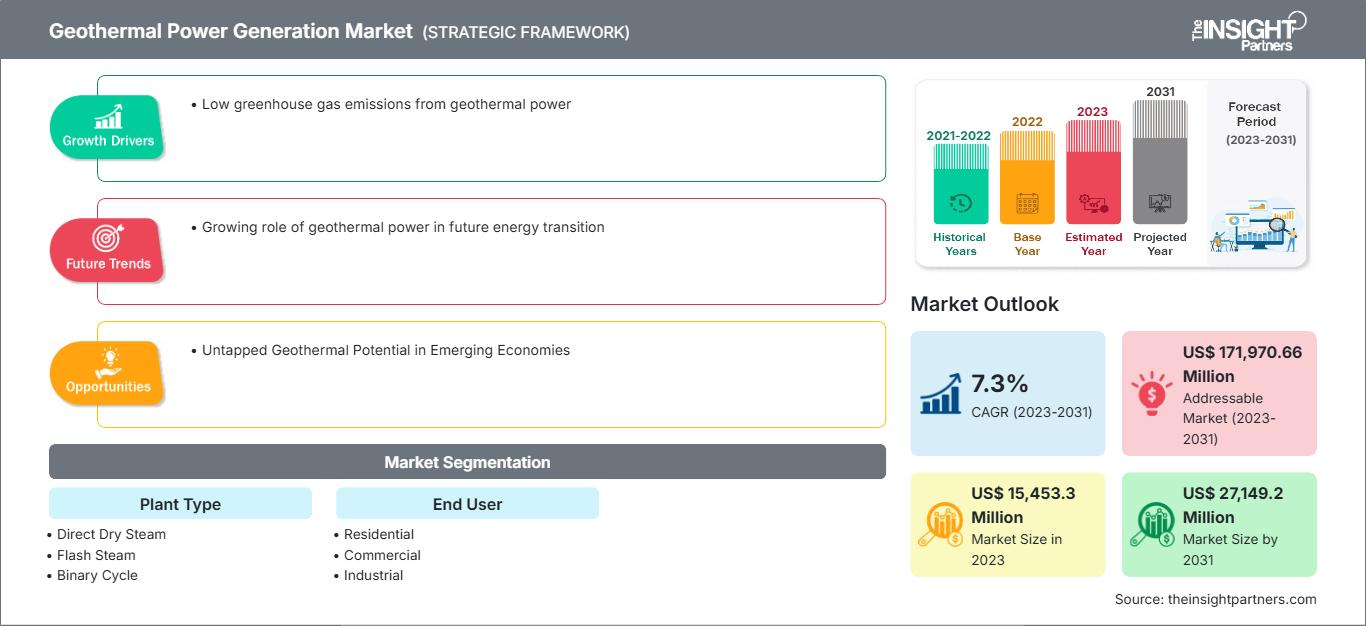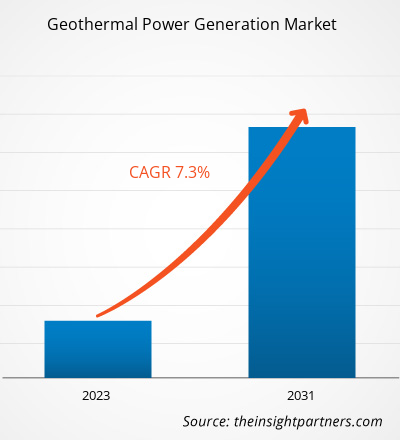Der Markt für geothermische Stromerzeugung soll von 15.453,3 Millionen US-Dollar im Jahr 2023 auf 27.149,2 Millionen US-Dollar im Jahr 2031 anwachsen. Für den Markt wird zwischen 2023 und 2031 eine durchschnittliche jährliche Wachstumsrate (CAGR) von 7,3 % erwartet. Die wachsende Rolle der Geothermie bei der zukünftigen Energiewende wird voraussichtlich ein wichtiger Markttrend bleiben.
Marktanalyse für geothermische Stromerzeugung
Geothermische Stromerzeugung ist eine saubere, nachhaltige und umweltfreundliche Methode, bei der die innere Wärme der Erde zur Stromerzeugung genutzt wird. Bei diesem Verfahren werden die natürlichen Dampf- oder Heißwasserreservoirs unter der Erdoberfläche ausgenutzt. Auf Entspannungsdampfkraftwerke entfielen weltweit 64,6 % des gesamten Marktanteils der geothermischen Stromerzeugung.
Darüber hinaus wird erwartet, dass die steigende Nachfrage nach Elektrizität von Endverbrauchern, beispielsweise aus dem privaten, gewerblichen und industriellen Sektor, das Marktwachstum im Prognosezeitraum ankurbelt. Industrielle Nutzer machten 45,4 % der gesamten geothermischen Stromerzeugung weltweit aus, was auf den steigenden Strombedarf für verschiedene industrielle Anwendungen wie Fertigung, Chemie, Petrochemie, Verarbeitung und andere zurückzuführen ist. Der größte Marktanteil der geothermischen Stromerzeugung entfiel im Jahr 2022 auf den asiatisch-pazifischen Raum, nämlich etwa 40,4 %.
Marktübersicht für geothermische Stromerzeugung
Das Wachstum des Marktes für geothermische Stromerzeugung hängt mit den geologischen Bedingungen zusammen, die für die Nutzung der inneren Wärme der Erde günstig sind. Die Geologie der Erde beeinflusst die globale Verbreitung der Geothermie, und Regionen mit hoher vulkanischer Aktivität, tektonischen Plattengrenzen oder Hotspots verfügen eher über bedeutende geothermische Ressourcen. Während einige Regionen bei der Entwicklung der Geothermie führend sind, erweitern technologische Fortschritte, wie z. B. verbesserte Geothermiesysteme (EGS), die Reichweite der Geothermie und machen sie weltweit zu einer zunehmend praktikablen Option für saubere und nachhaltige Energie.
Geothermie steht im Einklang mit den Zielen der globalen Energiewende, die auf die Reduzierung von CO2-Emissionen und die stärkere Nutzung erneuerbarer Energiequellen abzielen. Da sich Länder zu internationalen Abkommen wie dem Pariser Klimaabkommen verpflichten, spielt Geothermie eine immer wichtigere Rolle bei der Erreichung der CO2-Neutralität. Ihre Zuverlässigkeit und ihr geringer CO2-Ausstoß machen Geothermie zu einem integralen Bestandteil der Energiewende. Regierungen weltweit integrieren Geothermie in ihre Strategien zur Energiewende und setzen sich Ziele für den Ausbau erneuerbarer Energien und eine geringere Abhängigkeit von fossilen Brennstoffen. Der globale Wandel hin zu nachhaltigen Energiepraktiken unterstreicht die Bedeutung der Geothermie für das Erreichen umfassenderer Umwelt- und Klimaziele.
Passen Sie diesen Bericht Ihren Anforderungen an
Sie erhalten kostenlos Anpassungen an jedem Bericht, einschließlich Teilen dieses Berichts oder einer Analyse auf Länderebene, eines Excel-Datenpakets sowie tolle Angebote und Rabatte für Start-ups und Universitäten.
Markt für geothermische Stromerzeugung: Strategische Einblicke

-
Holen Sie sich die wichtigsten Markttrends aus diesem Bericht.Dieses KOSTENLOSE Beispiel umfasst Datenanalysen, die von Markttrends bis hin zu Schätzungen und Prognosen reichen.
Markttreiber und -chancen für die geothermische Stromerzeugung
Geringe Treibhausgasemissionen durch Geothermie begünstigen den Markt
Der weltweite Anstieg des Energiebedarfs, getrieben durch Bevölkerungswachstum und Industrialisierung, erfordert einen Ausbau der Energieerzeugung. Der Ausbau der Energieerzeugung aus fossilen Brennstoffen hat zu einem Anstieg der Treibhausgasemissionen geführt, was wiederum den Bedarf an erneuerbarer Energieerzeugung erhöhen dürfte. Daher wird erwartet, dass ein steigender Bedarf an der Reduzierung von Treibhausgasemissionen das Marktwachstum der geothermischen Stromerzeugung von 2023 bis 2031 vorantreiben wird.
Darüber hinaus zeichnet sich Geothermie durch geringe Treibhausgasemissionen sowohl während der Bauphase als auch während des Betriebs aus. Im Gegensatz zu fossilen Brennstoffkraftwerken produzieren Geothermieanlagen nur minimales Kohlendioxid und andere Schadstoffe. Die Emissionen entstehen hauptsächlich durch die Freisetzung geringer Mengen von Gasen wie Schwefelwasserstoff, die effektiv kontrolliert und gemindert werden. Die Umweltauswirkungen der Geothermie sind deutlich geringer als bei herkömmlichen Energiequellen, was sie zu einer saubereren und nachhaltigeren Option macht. Da die Länder bestrebt sind, ihren CO2-Fußabdruck zu verringern und den Klimawandel zu bekämpfen, ist die Geothermie aufgrund ihres niedrigen Emissionsprofils ein entscheidender Faktor beim Übergang zu einer grüneren und nachhaltigeren Energielandschaft.
Ungenutztes geothermisches Potenzial in Schwellenländern
Aus dem Erdinneren strömt Wärme, die den doppelten weltweiten Energiebedarf deckt. Um diese Wärme zu nutzen, muss tief in die Erde gebohrt und diese Wärme in eine nutzbare Energieform umgewandelt werden. Dies gilt als schwieriger und teurer Prozess. Daher trägt die Geothermie, die manchmal als vergessene erneuerbare Energie bezeichnet wird, nur etwa 0,3 % zur weltweiten Stromproduktion bei. Ein weiterer Hauptvorteil der Geothermie besteht darin, dass sie Grundlastkapazität bereitstellen kann. Dies ist die Mindestmenge an Strom, die zu einem bestimmten Zeitpunkt im Netz verfügbar sein muss. Während die Solar- und Windleistung saisonal und im Tagesverlauf schwankt, kann die geothermische Stromerzeugung auf die gleiche Weise angepasst werden, wie ein fossil befeuertes Kraftwerk seine Leistung erhöhen oder verringern kann.
Darüber hinaus ergreifen staatliche Initiativen zur Erschließung des ungenutzten geothermischen Potenzials weltweit. Um beispielsweise Ländern dabei zu helfen, das ungenutzte Potenzial der Geothermie freizusetzen und ihre breite Nutzung zu fördern, gründete die Internationale Agentur für Erneuerbare Energien (IRENA) 2015 die Global Geothermal Alliance (GGA) als Plattform zur Verbesserung des Dialogs, der Zusammenarbeit und der koordinierten Maßnahmen, um den Anteil der installierten geothermischen Energie und der Wärmeerzeugung weltweit zu erhöhen. Darüber hinaus sind Indonesien, die Türkei und Kenia wichtige Volkswirtschaften, die bis Ende 2030 voraussichtlich führend bei der geothermischen Stromerzeugung sein werden. Der Wirtschaftsentwicklungsplan mit dem Namen „Kenya Vision 2030“ der kenianischen Regierung zielt darauf ab, bis 2030 eine geothermische Kapazität von 5 GW zu erreichen. Daher wird erwartet, dass die Erschließung des ungenutzten geothermischen Potenzials in Schwellenländern im Prognosezeitraum mehrere Möglichkeiten für das Wachstum des Marktes für geothermische Stromerzeugung schafft.
Segmentierungsanalyse des Marktberichts zur geothermischen Stromerzeugung
Schlüsselsegmente, die zur Ableitung der Marktanalyse für geothermische Stromerzeugung beigetragen haben, sind Anlagentyp und Endverbraucher.
- Basierend auf dem Anlagentyp ist der Markt für geothermische Stromerzeugung in Direkt-Trockendampf, Entspannungsdampf und Binärzyklus unterteilt. Das Entspannungsdampfsegment hatte 2023 einen größeren Marktanteil.
- Nach Endverbraucher ist der Markt in Wohn-, Gewerbe- und Industriebereiche segmentiert. Das Industriesegment hatte 2023 den größten Marktanteil.
Marktanteilsanalyse der geothermischen Stromerzeugung nach Geografie
Der geografische Umfang des Marktberichts zur geothermischen Stromerzeugung ist hauptsächlich in fünf Regionen unterteilt: Nordamerika, Asien-Pazifik, Europa, Naher Osten und Afrika sowie Süd- und Mittelamerika.
Der Asien-Pazifik-Raum ist führend auf dem Markt. Dies ist auf die steigenden Investitionen in den Ausbau der Geothermiekapazität und die steigende Nachfrage nach sauberer Stromerzeugung in den kommenden Jahren zurückzuführen. Der Asien-Pazifik-Raum, insbesondere die Länder entlang des Pazifischen Feuerrings, ist reich an geothermischen Ressourcen. Die Philippinen sind ein bemerkenswertes Beispiel, da ein erheblicher Teil des Stroms aus Geothermiekraftwerken stammt. Auch Indonesien, Neuseeland, die Philippinen und Japan haben aktive Geothermieprojekte und Explorationsinitiativen. Indonesien, Neuseeland und die Philippinen machten im Jahr 2022 mehr als 75 % des gesamten globalen Marktes für geothermische Stromerzeugung aus und werden voraussichtlich auch im Prognosezeitraum ihre beherrschende Stellung auf dem Markt für geothermische Stromerzeugung beibehalten.
Geothermische Stromerzeugung
Regionale Einblicke in den Markt für geothermische StromerzeugungDie Analysten von The Insight Partners haben die regionalen Trends und Faktoren, die den Markt für geothermische Stromerzeugung im Prognosezeitraum beeinflussen, ausführlich erläutert. In diesem Abschnitt werden auch die Marktsegmente und die geografische Lage in Nordamerika, Europa, dem asiatisch-pazifischen Raum, dem Nahen Osten und Afrika sowie Süd- und Mittelamerika erörtert.
Umfang des Marktberichts zur geothermischen Stromerzeugung
| Berichtsattribut | Einzelheiten |
|---|---|
| Marktgröße in 2023 | US$ 15,453.3 Million |
| Marktgröße nach 2031 | US$ 27,149.2 Million |
| Globale CAGR (2023 - 2031) | 7.3% |
| Historische Daten | 2021-2022 |
| Prognosezeitraum | 2023-2031 |
| Abgedeckte Segmente |
By Anlagentyp
|
| Abgedeckte Regionen und Länder |
Nordamerika
|
| Marktführer und wichtige Unternehmensprofile |
|
Dichte der Marktteilnehmer im Bereich der geothermischen Stromerzeugung: Verständnis ihrer Auswirkungen auf die Geschäftsdynamik
Der Markt für geothermische Stromerzeugung wächst rasant. Die steigende Nachfrage der Endverbraucher ist auf Faktoren wie veränderte Verbraucherpräferenzen, technologische Fortschritte und ein stärkeres Bewusstsein für die Produktvorteile zurückzuführen. Mit der steigenden Nachfrage erweitern Unternehmen ihr Angebot, entwickeln Innovationen, um den Bedürfnissen der Verbraucher gerecht zu werden, und nutzen neue Trends, was das Marktwachstum weiter ankurbelt.

- Holen Sie sich die Markt für geothermische Stromerzeugung Übersicht der wichtigsten Akteure
Neuigkeiten und aktuelle Entwicklungen zum Markt für geothermische Stromerzeugung
Der Markt für geothermische Stromerzeugung wird durch die Erhebung qualitativer und quantitativer Daten aus Primär- und Sekundärforschung bewertet, die wichtige Unternehmensveröffentlichungen, Verbandsdaten und Datenbanken umfasst. Einige der Entwicklungen auf dem Markt für geothermische Stromerzeugung sind nachfolgend aufgeführt:
- Fervo Energy beginnt mit dem Bau eines Geothermiekraftwerks der nächsten Generation. Diese Anlage verfügt über 400 MW und befindet sich in Beaver County, Utah. Fervo Energy wird verbesserte Geothermietechnologie zur Nutzung von Wärmequellen einsetzen. (Quelle: Fervo Energy, Pressemitteilung, September 2023)
- Exergy International (Anbieter sauberer Energietechnologie) hat einen Vertrag mit der Energy Development Corporation (EDC) über die Lieferung eines 28-MW-Binärsystemkraftwerks in Leyte, Eastern Visayas (Philippinen) unterzeichnet. (Quelle: Exergy International, Pressemitteilung, August 2023)
Bericht zum Markt für geothermische Stromerzeugung: Umfang und Ergebnisse
Der Bericht „Marktgröße und Prognose für geothermische Stromerzeugung (2021–2031)“ bietet eine detaillierte Analyse des Marktes und deckt die folgenden Bereiche ab:
- Marktgröße und Prognose für geothermische Stromerzeugung auf globaler, regionaler und Länderebene für alle abgedeckten wichtigen Marktsegmente
- Markttrends und Marktdynamiken für geothermische Stromerzeugung wie Treiber, Einschränkungen und wichtige Chancen
- Detaillierte PEST- und SWOT-Analyse
- Marktanalyse für geothermische Stromerzeugung mit wichtigen Markttrends, globalen und regionalen Rahmenbedingungen, wichtigen Akteuren, Vorschriften und aktuellen Marktentwicklungen
- Branchenlandschaft und Wettbewerbsanalyse mit Marktkonzentration, Heatmap-Analyse, prominenten Akteuren und aktuellen Entwicklungen für den Markt für geothermische Stromerzeugung
- Detaillierte Unternehmensprofile
- Historische Analyse (2 Jahre), Basisjahr, Prognose (7 Jahre) mit CAGR
- PEST- und SWOT-Analyse
- Marktgröße Wert/Volumen – Global, Regional, Land
- Branchen- und Wettbewerbslandschaft
- Excel-Datensatz
Aktuelle Berichte
Verwandte Berichte
Erfahrungsberichte
Grund zum Kauf
- Fundierte Entscheidungsfindung
- Marktdynamik verstehen
- Wettbewerbsanalyse
- Kundeneinblicke
- Marktprognosen
- Risikominimierung
- Strategische Planung
- Investitionsbegründung
- Identifizierung neuer Märkte
- Verbesserung von Marketingstrategien
- Steigerung der Betriebseffizienz
- Anpassung an regulatorische Trends






















 Kostenlose Probe anfordern für - Markt für geothermische Stromerzeugung
Kostenlose Probe anfordern für - Markt für geothermische Stromerzeugung